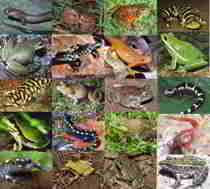
New Mexico Symbols
New Mexico State Amphibian
New Mexico Spadefoot Toad

(Spea multiplicata)
Adopted in 2003.
The New Mexico spadefoot toad, or Spea multiplicata, is named for the sharpedged scrapers on the underside of its hind feet. Using its hind feet, the spadefoot toad burrows deep underground to avoid dehydration. The spadefoot is nocturnal, and is rarely seen above ground when the weather is dry. It can eat as much as one-half of its body weight in one night's feeding and can store enough fat to survive for a year or more underground. House Bill No. 13, adopting the New Mexico Spadefoot Toad as the official state amphibian, the New Mexico Whiptail Lizard as the official state reptile and the Sandia Hairstreak Butterfly as the official state butterfly was approved by the New Mexico House of Representatives on February 5, 2003. It was approved by the Senate on March 19, 2003. The bill was signed by Governor Richardson on April 6, 2003. This bill also placed "The Land of Enchantment" in the statutes as the official state nickname of New Mexico.
New Mexico State Amphibian:
New Mexico Spadefoot Toad

Short, round, and squat, the New Mexico spadefoot is the most common spadefoot in the park. All spadefoots are distinguished by a thick spade-like structure on their hind feet used to dig their burrows. Like most amphibians, they spend most of the year underground. The New Mexico spadefoot is gray or tan in color with red spots.
Maximum snout-vent length 2-1/2". Color greenish, gray, or brown, with scattered darker spots or blotches. No lump between eyes. Wedge-shaped spade on each hind foot. Eye with vertical pupil in bright light.
Diet:
Mexican spadefoots eat a variety of invertebrate prey, such as termites, ants, beetles, and spiders. They apparently avoid arthropods with toxins or chemical defenses, such as velvet ants and blister beetles. In the San Simon Valley about half the diet of Mexican spadefoots was found to consist of winged termites. Tadpoles are carnivorous.
Natural History:
- Habitat:
-
The Mexican spadefoot is widely distributed in Arizona, from Sonoran Desert and Chihuahuan Desert scrub in southern Arizona, to Great Basin Desert
scrub, grasslands, and coniferous woodlands in northern Arizona. It can be found in agriculture, particularly the desert edge of agriculture, in
southern Arizona.
- Behavior:
-
It is nocturnal, but is rarely seen without rain. This spadefoot remains buried in soil for months and then emerges with the onset of the summer
monsoons. The call is reminiscent of running a fingernail along the teeth of a comb. Males usually call from the middle of a pond, often swimming
around without being anchored.
- Breeding:
-
It breeds in temporary rain pools that fill during summer storms. Breeding occurs from January to August with rain. Eggs hatch within 48 hours and
the tadpoles develop quickly
New Mexico Statutes
The law designating the spadefoot toad as the official New Mexico state amphibian is Section 12-3-4 of the 2013 New Mexico Statutes, Chapter 12, Article 3 (State Seal, Song and Symbols) Section 12-3-4.P
Chapter 12 - Miscellaneous Public Affairs Matters
Article 3 - State Seal, Song and Symbols
Section 12-3-4 - State flower; state bird; state tree; state fish; state animal; state vegetables; state gem; state grass; state fossil; state cookie;
state insect; state question; state answer; state nickname; state butterfly; state reptile; state amphibian; state amphibian; state aircraft; state
historic railroad; state tie; state necklace.
Universal Citation: NM Stat § 12-3-4 (2013)
12-3-4. State flower; state bird; state tree; state fish; state animal; state vegetables; state gem; state grass; state fossil; state cookie; state
insect; state question; state answer; state nickname; state butterfly; state reptile; state amphibian; state aircraft; state historic railroad; state
tie; state necklace. (2011)
A. The yucca flower is adopted as the official flower of New Mexico.
B. The chaparral bird, commonly called roadrunner, is adopted as the official bird of New Mexico.
C. The nut pine or pinon tree, scientifically known as Pinus edulis, is adopted as the official tree of New Mexico.
D. The native New Mexico cutthroat trout is adopted as the official fish of New Mexico.
E. The native New Mexico black bear is adopted as the official animal of New Mexico.
F. The chile, the Spanish adaptation of the chilli, and the pinto bean, commonly known as the frijol, are adopted as the official vegetables of New
Mexico.
G. The turquoise is adopted as the official gem of New Mexico.
H. The blue grama grass, scientifically known as Bouteloua gracillis, is adopted as the official grass of New Mexico.
I. The coelophysis is adopted as the official fossil of New Mexico.
J. The bizcochito is adopted as the official cookie of New Mexico.
K. The tarantula hawk wasp, scientifically known as Pepsis formosa, is adopted as the official insect of New Mexico.
L. "Red or green?" is adopted as the official question of New Mexico.
M. "Red and green or Christmas" is adopted as the official answer of New Mexico.
N. "The Land of Enchantment" is adopted as the official nickname of New Mexico.
O. The Sandia hairstreak is adopted as the official butterfly of New Mexico.
P. The New Mexico whiptail lizard, scientifically known as Cnemidophorus neomexicanus, is adopted as the official reptile of New Mexico.
Q. The New Mexico spadefoot toad, scientifically known as Spea multiplicata, is adopted as the official amphibian of New Mexico.
R. The hot air balloon is adopted as the official aircraft of New Mexico.
S. The Cumbres and Toltec scenic railroad is adopted as the official historic railroad of New Mexico.
T. The bolo tie is adopted as the official tie of New Mexico.
U. The Native American squash blossom necklace is adopted as the official necklace of New Mexico.
History: Laws 1927, ch. 102, § 1; C.S. 1929, § 129-101; 1941 Comp., § 3-1303; Laws 1949, ch. 142, § 1; 1953 Comp., § 4-14-3;
Laws 1955, ch. 245, § 1; 1963, ch. 2, § 1; 1965, ch. 20, § 1; 1967, ch. 51, § 1; 1967, ch. 118, § 1; 1973, ch. 95, §
1; 1981, ch. 123, § 1; 1989, ch. 8, § 1; 1989, ch. 154, § 1; 1999, ch. 266, § 1; 1999, ch. 271, § 1; 2003, ch. 182, §
1; 2005, ch. 4, § 1; 2005, ch. 254, § 1; 2007, ch. 10, § 1; 2007, ch. 179, § 1; 2011, ch. 52, § 1.
Taxonomic Hierarchy: New Mexico Spadefoot Toad
Kingdom: Animalia
Phylum: Chordata
Class: Amphibia
Order: Anura
Suborder: Mesobatrachia
Family: Scaphiopodidae
Genus: Spea
Species: S. multiplicata







